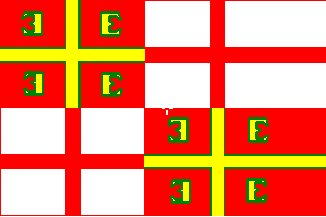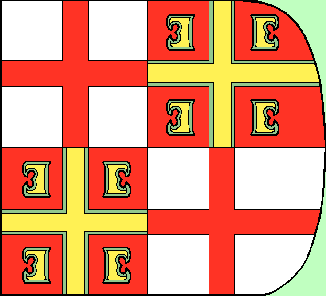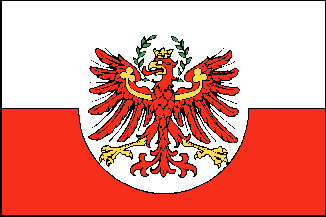
by Giuseppe Bottasini, 24 June 1996

Last modified: 2005-01-08 by dov gutterman
Keywords: italy | padania | lega nord | romagna | sud tyrol | tuscany | trentino | veneto | venezia giulia | umbria |
Links: FOTW homepage |
search |
disclaimer and copyright |
write us |
mirrors
See also:

by Giuseppe Bottasini, 24 June 1996
In two quarters there is the red cross on white field, while
in the other two quarters there is a yellow cross (green
fimbriated) on a red field and 4 yellow green-fimbriated
"C" (something like the Serbian flag).
Giuseppe Bottasini, 19 September 1996
A flag for Romagna is proposed: in two quarters there is the
red cross on white field, while in the other two quarters there
is a yellow cross (green fimbriated) on a red field and 4 yellow
green-fimbriated "C" (something like the Serbian flag).
It has clearly Byzantine roots.
Mario Fabretto, 20 September 1996
Romagna: quartered 1-4 red cross on white; 2-3 yellow cross on
red and in each red quarter a letter like the ones in the serbian
arms.
Jaume Olle', 29 December 1998
"Romagna" is identical to the Byzantine
one. Romagna belonged to Byzantine Empire for a long time. This
may explain the adoption of Byzantine flag by the Romagna
autonomist movement. The logo of the autonomist movement of
Romagna includes the flag. See its site
Giuseppe Bottasini, 29 August 2000

by Matteo Colaone, 29 September 2000
The proposed flag by Lega Nord and other Autonomist Movements
is directly derives from the old Byzantine Empire flag that was
created (according to "Libro del conoscimento de todos los
reynos", XIV sec.) by the combination of San Giorgio cross
and Paleologo dinasty's flag. The four symbols on Paleologo flag
could be "B" letters in greek alphabet, that could
stand for the motto: "Re dei re regnante sui re". The
Byzantine Domine was the only power that gave unity to Romagna
land (Esarcato e Pentapoli).
Paleologo's CoA is also present in 'Casale Monferrato' (Piemont)
CoA, in 'Ducato di Mantova' CoA, and in 'Paleologo of Monferrato'
family's CoA.
Matteo Colaone, 29 August 2000
This emblem was drawn on bysantine coins in VI century and on
banner (labarum) of emperor Constantin. This is the flag of the
Byzantine Empire under the Paleologues' dinasty and it's a copy
of the one in Neubecker's "Heraldry - sources, symbols and
meaning (1976), p. 106. (incl the rounded corners)
Victor Lomantsov, 1 October 2000 ,Santiago Dotor
and Jarig Bakker, 3 October 2000
Indeed it is the Byzantine flag. Most probably it was chosen
by the "autonomists" there (a very very small minority)
because Romagna was Byzantine for a lot of time before being
"inherited" by the State of the church. Outside this
recent choice it has not any tradition of use in Romagna. The
most famous Italian coat of arms bearing the flag or arms of
Byzantium was NOT used in Romagna but was used in the Marchesato
del Monferrato (a sub region of Piedmont, between Turin and
Genoa), and also in Mantua. Both Monferrato and Mantua were
ruled at a stage by the Gonzaga Family which had some Paleologue
Byzantine ancestor, so for Monferrato and Mantua the Paleologue
Cross with 4 B is definitely there because of of some
family heraldic reason. What I remember without consultin
some book is that some Byzantine noblemen of the Paleologue
imperial dynasty settled in Italy I guess because of political
dissent with a new emperor in Constantinople (and more Byzantines
people and nobles took refuge in Italy at the time of the fall of
Byzantium to the invading turkish army in 1453). The south
slavians tribes of invaders which arrived in Illyria in the VII
century of our era, when began to reach the stage of forming
their kingdom adopted the trappings and symbols of the far
more complex ancient civilization of Byzantium and so from
Constantinople they usurped the eagle (which they re painted
white instead of gold) as a symbol of sovereignity and the red S.
George cross,too and the golden cross with the four golden B in
the four quarters. The "B" comes from basileus =
Greek for king and/or emperor and there were 4 because of a
Greek phrase saying something like king of the king reigning over
kings. The four Byzantine B in the serbian flags became four C.
Marcus Prometheus, 1 October 2000
Other Reported Flags
Has anyone ever seen this
flag I have found in an Italian site about dialects?
It is supposed to be a flag of Romagna, even if the site no
longer shows it.
Paolo Montanelli, 24 June 2003
In Flag Report 24, regarding to Romagna, a flag was published
that has a resemblance with the one posted by Paolo
Montanelli. The roster bear a scepter like the one pictured
in the flag. This flag, I believe, is used by the Leghiste
(followers of the Padanian Leagues). The text say: Flag adopted
(for use) toward September 2000. Yellow and red are the
national colors of Romagna. the cross fimbreated white symbolizes
to the romagnolos as one of the peoples of the Padania (whose
historical flag is red cross in white field); the rooster
represents to the ancestres, the Senon Gauls, and carries the
sceptre used by the ancient Celtic. Has four tones of blue
probably somewhat more strong that in the image (where the tones
correspond to those of the photo).
Jaume Olle', 25 June 2003
see also: Emilia-Romagna Region and Byzantine Empire

by Matteo Colaone, 5 October 2000
SudTirolesi uses a white-red flag with the eagle.
Giuseppe Bottasini, 19 September 1996
Sud Tyrol - white over red with arms in center (white with red
eagle armed and tongued yellow and crowned with green laurel).
Jaume Olle', 29 December 1998
This flag (Horizontal white-red with shield bearing an eagle) is listed under number 47 at the chart "Flags of Aspirant Peoples" [eba94] as: "South Tyrol [Su¨d Tirol] (Austrians of Alto